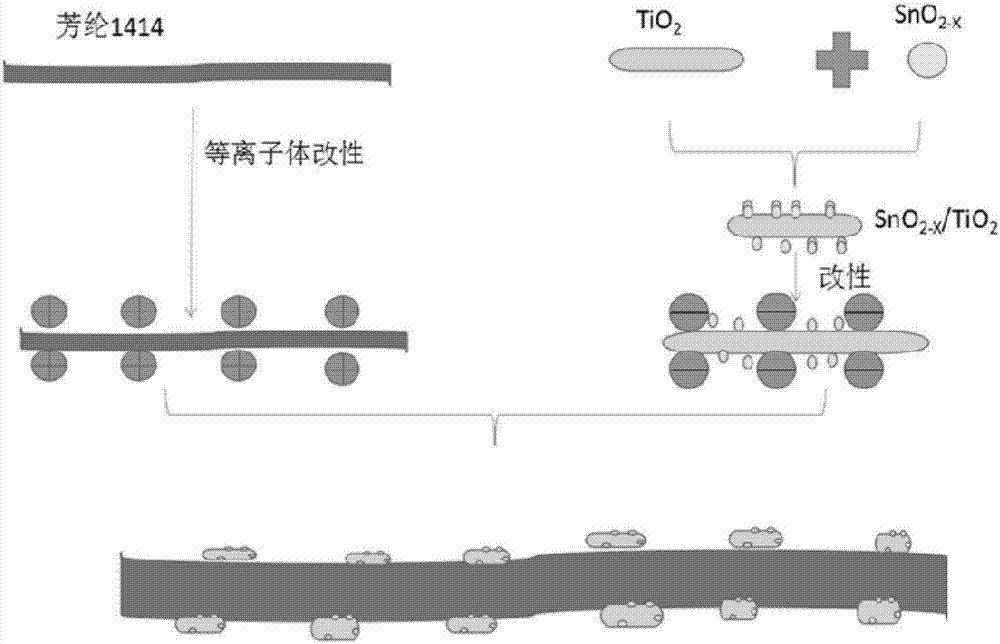Preparation method of visible light composite photocatalyst and finishing method for fabric by visible light composite photocatalyst
A technology of composite light and visible light, applied in the field of textile materials, can solve the problems of low quantum efficiency, application hindrance, low energy efficiency, etc., and achieve the effect of high activity, high energy efficiency, efficient and durable self-cleaning performance
- Summary
- Abstract
- Description
- Claims
- Application Information
AI Technical Summary
Problems solved by technology
Method used
Image
Examples
preparation example Construction
[0024] A method for preparing a visible light composite photocatalyst according to an embodiment of the present invention comprises the following steps:
[0025] Step 101): preparing titanium dioxide nanobelts.
[0026] Step 102): preparing a self-doping tin dioxide precursor solution; the chemical formula of the self-doping tin dioxide is SnO 2-x . Wherein, x represents the doping ratio of divalent tin, and the value of x ranges from 0 to 1. The value of x can be 1, 0 or a value between 0 and 1.
[0027] Step 103): preparing self-doped tin dioxide and titanium dioxide nanobelt heterostructure visible light composite photocatalyst.
[0028] Step 104): Perform surface modification on the visible light composite photocatalyst prepared in step 103) to prepare anion-modified visible light composite photocatalyst.
[0029] In the above embodiment, as a preference, the process of step 101) is: dissolving the titanium dioxide powder in a NaOH solution with a molar concentration o...
Embodiment 1
[0044] Step 1): preparing a visible light composite photocatalyst, including:
[0045] Step 101): dissolving titanium dioxide powder in a NaOH solution with a molar concentration of 10 mol / L, the mass concentration of titanium dioxide being 5 g / L, ultrasonically stirring the solution, and then placing the solution in a polytetrafluoroethylene-lined stainless steel reaction kettle, After reacting at 150°C for 4 to 5 hours, the reaction product was taken out and cooled to room temperature, the reaction product was washed with deionized water until the pH value was 7, the alkali and sodium titanate were removed, and sodium trititanate nanobelts were obtained; the sodium trititanate nanobelts were Place in a hydrochloric acid solution with a molar concentration of 0.1mol / L, soak for 44 hours, wash the reaction product with deionized water until the pH value is 7, remove excess acid, chloride ions and sodium ions, and obtain titanate nanobelts; bake at 65°C Dry titanate nanobelts t...
Embodiment 2
[0052] Step 1): preparing a visible light composite photocatalyst, including:
[0053] Step 101): dissolving the titanium dioxide powder in a NaOH solution with a molar concentration of 5 mol / L, the mass concentration of titanium dioxide being 8 g / L, ultrasonically stirring the solution, and then placing the solution in a polytetrafluoroethylene-lined stainless steel reaction kettle, After reacting at 160°C for 48 hours, take out the reaction product and cool it to room temperature, wash the reaction product with deionized water until the pH value is 7, remove the alkali and sodium titanate, and obtain sodium trititanate nanobelts; place the sodium trititanate nanobelts After soaking in a hydrochloric acid solution with a molar concentration of 0.05mol / L for 42 hours, wash the reaction product with deionized water until the pH value is 7, remove excess acid, chloride ions and sodium ions, and obtain titanate nanobelts; dry at 70°C Titanate nanobelts are formed into titanate na...
PUM
| Property | Measurement | Unit |
|---|---|---|
| specific surface area | aaaaa | aaaaa |
Abstract
Description
Claims
Application Information
 Login to View More
Login to View More - Generate Ideas
- Intellectual Property
- Life Sciences
- Materials
- Tech Scout
- Unparalleled Data Quality
- Higher Quality Content
- 60% Fewer Hallucinations
Browse by: Latest US Patents, China's latest patents, Technical Efficacy Thesaurus, Application Domain, Technology Topic, Popular Technical Reports.
© 2025 PatSnap. All rights reserved.Legal|Privacy policy|Modern Slavery Act Transparency Statement|Sitemap|About US| Contact US: help@patsnap.com


